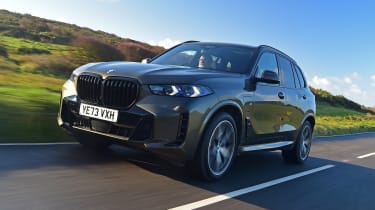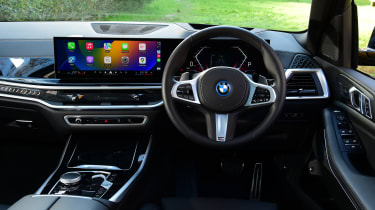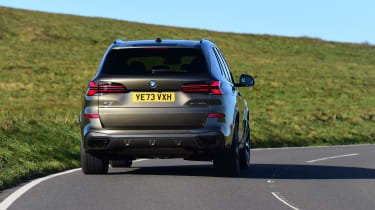Updates to the BMW X5 only consolidate an impressive all-round package, bolstered by this excellent plug-in powertrain
4.5 out of 5
How we review carsFind your BMW X5Offers from our trusted partners on this car and its predecessors…
On the road it’s impossible not to be blown away by the X5’s superb refinement and comfortable ride. With a fully-charged battery, it’s easy to forget there’s a straight-six petrol engine under the bonnet; the X5’s powerful electric motor is more than capable of hauling its not-inconsiderable mass with ease.
Around town, the excellent forward visibility and light steering make it easy to place and surprisingly simple to drive in tight spaces – despite its big external dimensions. The ride is very well judged, appearing plush without feeling over-soft.
With the battery depleted, the engine will fire up almost imperceptibly, leveraging its inherent smoothness to create an impressive sense of calm. Dig a little deeper, though, and the X5 feels rapid – with impressive acceleration bolstered by the e-motor’s instant torque.
Being a modern BMW, there are lots of settings to play around with, and in Hybrid mode the car will flow along the road with little indication of whether it’s the petrol or electric motor providing drive. In Sport, however, the petrol engine becomes far more vocal, and drives much more akin to a pure petrol car, only with an added lump of electric power and torque.
Calibrating complex plug-in hybrid powertrains like this is a very tricky task for any manufacturer. But BMW seems to have a good hold on it in the X5, rarely feeling caught out or confused by sudden inputs. We only found it crossed up once or twice when pulling out of junctions with urgency, where the engine and motor join forces to give you perhaps a little too much performance. But in general the system is more adept than those found in this car’s key rivals.
As with all plug-in hybrids, economy does suffer when the battery is used up. Over the course of our test we covered 450-odd miles in mixed city and motorway driving, achieving around 43.5mpg. This sounds impressive for a car of this size, but 184 miles of those were completed in all-electric mode, meaning that actual fuel consumption for the distance covered on petrol power stood at just 25.9mpg. If you consistently drive long distances and exceed the electric range between charging, a diesel-powered X5 will be more efficient. The X5 also only accepts 11kW AC charging, so a full battery refill will take over 4 hours.
The rest of the package is typical X5, which means there’s lots of space in the second row, and a large square boot accessible through a powered split tailgate. The plug-in hybrid does have a touch less boot space than other X5s, with 500 rather than 650 litres. Nor does BMW offer seven-seat options on UK models, leaving that end of the market for the larger X7.
Against key rivals, the X5 is still on top when it comes to striking a balance between a comfortable and luxurious driving experience, but still feeling balanced and fun to drive. A Porsche Cayenne E-Hybrid is more overtly sporty, with a firmer ride and sharper steering, while the softer Mercedes GLE 400e can feel more cumbersome without being any more comfortable. Balance is a talent that that X5 has always possessed, and that continues four generations in.
| Model: | BMW X5 xDrive50e M Sport |
| Price: | £79,265 |
| Engine: | 3.0-litre turbo-petrol, plug-in hybrid |
| Power/torque: | 483bhp/700Nm |
| Transmission: | Eight-speed auto, four-wheel drive |
| 0-62mph: | 4.8 seconds |
| Top speed: | 155mph |
| Economy/CO2: | 353mpg/19g/km |
| On sale: | Now |
Source: Read Full Article




